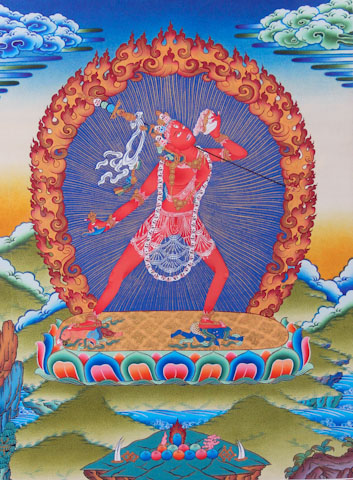Vajrayogini
Vajrayogini is a tantric Buddhist meditational deity, the most important of the dakinis, or sky-goers. She embodies the shakti (power) aspect of a buddha, the wisdom of experience, and the passion required to attain enlightenment. Her duality occurs in the fact that she is both a guide and an essence of what it means to be a buddha.
Appearance
Young, naked, and sensuous, Vajrayogini has a deep red body to signify the heat and fire of wisdom. Her hair is long and wild, and she wears a garland of human skulls around her neck. The third eye sits vertically on her forehead, a reminder that she can see past, present, and future. Her single face emphasizes that emptiness has only one nature; her two arms refer to the realization of the two truths. The left hand holds a skullcup filled with blood, symbolizing her experience of bliss, while the right holds a curved knife, a weapon to destroy the delusions and obstacles of all living beings.
Dance
The Vajrayogini dance is a highly stylized form of artistic expression which requires a variety of controlled movements, including representations of the dakini and her many attributes. Every single dimension of the dance is choreographed to highlight the physical and spiritual qualities of the goddess. The dancer herself must portray both the role of devotee and deity, demonstrating the interconnection and interaction between the two. Correct mudras, abhinaya, body posture, and foot patterning are essential to the dance, and require many years to perfect.
The vocal accompaniment for the Vajrayogini dance is usually performed by a woman, with the addition of a background drum to set the rhythm at the onset of the piece.
